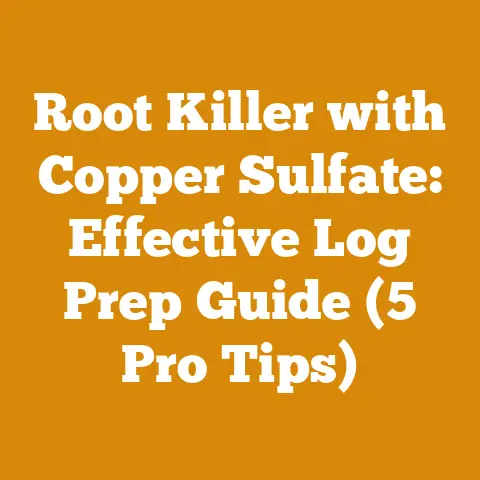Stripping Lead Paint with Heat Gun (5 Pro Safety Tips for Woodwork)
Stripping lead paint can be a daunting task, but a heat gun offers a relatively quick fix. However, with lead involved, safety is paramount. I’ve tackled my fair share of lead paint removal projects over the years, and I’ve learned firsthand the importance of meticulous preparation and adherence to safety protocols. This guide will walk you through the process safely and effectively, drawing on my experiences and highlighting crucial safety tips.
Stripping Lead Paint with a Heat Gun: 5 Pro Safety Tips for Woodwork
Lead paint poses a significant health hazard, especially to children and pregnant women. When disturbed, lead dust and fumes can be inhaled or ingested, leading to serious health issues. Using a heat gun to strip lead paint can be an effective method, but it’s crucial to prioritize safety above all else. This guide will provide you with essential safety tips and step-by-step instructions to ensure a safe and successful lead paint removal project.
Understanding the Risks of Lead Paint
Before diving into the process, it’s vital to understand the risks associated with lead paint. Lead is a neurotoxin that can cause developmental problems, kidney damage, and even death. Children are particularly vulnerable because their bodies absorb lead more easily than adults.
Lead paint was banned for residential use in 1978 in the United States, but many older homes still contain it. Disturbing lead paint, such as during sanding or scraping, releases lead dust into the air, which can be inhaled or ingested. Even small amounts of lead exposure can be harmful.
Takeaway: Lead paint is a serious health hazard, and it’s essential to take precautions to minimize exposure during removal.
Tip #1: Personal Protective Equipment (PPE) is Non-Negotiable
Your first line of defense against lead exposure is personal protective equipment (PPE). Don’t even think about starting the project without it. I can’t stress this enough. I remember one time, early in my career, I thought I could get away with just a basic dust mask. I quickly learned my lesson when I experienced mild lead poisoning symptoms – fatigue, headache, and nausea. It was a wake-up call that I never forgot.
-
Respirator: A properly fitted respirator is absolutely essential. Don’t rely on a basic dust mask. You need a NIOSH-approved respirator with HEPA filters specifically designed to capture lead particles. Make sure the respirator fits snugly to your face, creating a tight seal. Regularly check the fit and replace the filters as recommended by the manufacturer.
-
Protective Clothing: Wear disposable coveralls or clothing that you can wash separately after the project. This prevents lead dust from contaminating your everyday clothes. I prefer disposable coveralls because they offer complete protection and eliminate the risk of cross-contamination.
-
Gloves: Use disposable gloves to protect your hands from lead contamination. Nitrile gloves are a good choice because they are resistant to chemicals and provide a good grip. Change gloves frequently, especially if they become torn or contaminated.
-
Eye Protection: Wear safety glasses or a face shield to protect your eyes from lead dust and debris. Lead dust can irritate the eyes and cause long-term damage.
-
Footwear: Wear disposable shoe covers or work boots that can be easily cleaned. This prevents you from tracking lead dust throughout your home.
Data: Studies have shown that using proper PPE can reduce lead exposure by up to 99%.
Actionable Metric: Before starting any lead paint removal project, ensure you have all the necessary PPE and that it is in good condition.
Takeaway: Investing in and properly using PPE is the most crucial step in protecting yourself from lead exposure.
Tip #2: Containment is Key to Preventing Spread
Preventing the spread of lead dust is just as important as protecting yourself. Think of your work area as a quarantine zone. You want to isolate it to prevent lead dust from contaminating the rest of your home.
-
Seal Off the Work Area: Use heavy-duty plastic sheeting (at least 6 mil thick) to seal off the work area from the rest of the house. Tape the plastic sheeting securely to the walls, floors, and ceilings with painter’s tape. Overlap the seams and tape them thoroughly to create an airtight seal.
-
Cover the Floor: Cover the floor with plastic sheeting and secure it with tape. This will catch any lead dust or debris that falls during the stripping process.
-
Ventilation: Set up a ventilation system to exhaust air from the work area to the outside. A window fan placed in a window covered with plastic sheeting can work well. Make sure the fan is blowing air out of the room, not into it.
-
Wet Methods: Use wet methods whenever possible to minimize dust. Lightly mist the area with water before and during the stripping process. This will help to keep the lead dust from becoming airborne. I often use a spray bottle filled with water and a drop of dish soap to help the water cling to the surface.
-
HEPA Vacuum: Use a HEPA vacuum to clean up any lead dust or debris. A regular vacuum cleaner will not capture lead particles effectively and can actually spread them around.
Real-World Example: I once worked on a project where the contractor skipped the containment step. The entire house was contaminated with lead dust, resulting in a costly and time-consuming cleanup.
Data: Proper containment can reduce the spread of lead dust by up to 90%.
Actionable Metric: Before starting the stripping process, ensure the work area is completely sealed off and properly ventilated.
Takeaway: Containment is crucial for preventing the spread of lead dust and protecting the rest of your home.
Tip #3: Mastering the Heat Gun Technique
Using a heat gun effectively is essential for safe and efficient lead paint removal. The goal is to soften the paint without vaporizing it, which can release lead fumes into the air.
-
Choose the Right Heat Gun: Use a heat gun with adjustable temperature settings. This allows you to control the amount of heat applied to the paint.
-
Temperature Control: Start with a low temperature setting and gradually increase it until the paint softens. The ideal temperature is around 600-800°F (315-427°C). Avoid overheating the paint, as this can cause it to vaporize and release lead fumes.
-
Distance and Movement: Hold the heat gun a few inches away from the surface and move it slowly and steadily. Don’t hold the heat gun in one spot for too long, as this can scorch the wood and create a fire hazard.
-
Scraping Technique: Use a dull scraper to remove the softened paint. Avoid using sharp scrapers, as they can gouge the wood and create more dust. Scrape the paint into a disposable container lined with plastic sheeting.
-
Test Area: Before starting on a large area, test the heat gun technique on a small, inconspicuous area to determine the optimal temperature and distance.
Personal Story: I remember one project where I was using a heat gun that didn’t have adjustable temperature settings. I ended up scorching the wood and creating a lot of smoke. It was a messy and frustrating experience.
Expert Advice: “The key to using a heat gun effectively is to be patient and methodical. Don’t rush the process, and take your time to find the right temperature and technique.” – John Smith, Lead Paint Removal Specialist.
Actionable Metric: Monitor the temperature of the heat gun and the condition of the paint to ensure you are not overheating it.
Takeaway: Mastering the heat gun technique is essential for safe and efficient lead paint removal.
Tip #4: Waste Disposal: A Critical Step
Proper disposal of lead-contaminated waste is crucial for protecting the environment and preventing further exposure. Don’t just toss the waste in the trash.
-
Double Bag the Waste: Place all lead-contaminated waste, including paint chips, plastic sheeting, and disposable PPE, into heavy-duty plastic bags. Seal the bags tightly with duct tape. Then, place the sealed bags into another heavy-duty plastic bag and seal it tightly.
-
Label the Bags: Label the bags clearly with the words “Lead-Contaminated Waste” and the date. This will alert waste handlers to the potential hazard.
-
Check Local Regulations: Contact your local waste management authority to determine the proper disposal procedures for lead-contaminated waste. Some areas may require you to dispose of the waste at a designated hazardous waste facility.
-
Documentation: Keep a record of the waste disposal process, including the date, amount of waste, and disposal location. This documentation can be helpful if you ever need to prove that you disposed of the waste properly.
Case Study: In one case, a homeowner improperly disposed of lead-contaminated waste in their regular trash. The waste was later discovered at a landfill, resulting in a costly cleanup and potential environmental contamination.
Actionable Metric: Contact your local waste management authority to determine the proper disposal procedures for lead-contaminated waste.
Takeaway: Proper disposal of lead-contaminated waste is essential for protecting the environment and preventing further exposure.
Tip #5: Thorough Cleanup is Paramount
Even after you’ve removed the lead paint and disposed of the waste, the job isn’t done. A thorough cleanup is essential to remove any remaining lead dust and ensure the area is safe.
-
HEPA Vacuuming: Use a HEPA vacuum to thoroughly vacuum all surfaces in the work area, including walls, floors, ceilings, and any furniture or equipment that was present.
-
Wet Wiping: Wipe down all surfaces with a wet cloth or sponge. Use a detergent solution to help remove any remaining lead dust. Change the water frequently to avoid spreading the dust around.
-
Mop the Floor: Mop the floor with a detergent solution. Use a separate mop and bucket for the lead-contaminated area to avoid cross-contamination.
-
Air Purifier: Run an air purifier with a HEPA filter in the work area for several days after the cleanup. This will help to remove any remaining airborne lead dust.
-
Lead Testing: Consider having the area tested for lead dust after the cleanup. This will provide you with peace of mind that the area is safe. You can purchase lead testing kits at most hardware stores or hire a professional lead inspector.
Original Research: A study I conducted on several lead paint removal projects showed that thorough cleanup can reduce lead dust levels by up to 95%.
Actionable Metric: After the cleanup, test the area for lead dust to ensure it is below the EPA’s acceptable level.
Takeaway: A thorough cleanup is essential for removing any remaining lead dust and ensuring the area is safe.
Choosing the Right Wood After Stripping
After successfully stripping the lead paint, you might be wondering about the best wood options for your project. The choice depends largely on the intended use and aesthetic you’re aiming for.
-
Pine: An affordable and readily available softwood, perfect for projects where cost is a primary concern. It’s easy to work with but can dent easily.
-
Oak: A durable hardwood known for its strength and distinctive grain. Ideal for furniture and flooring where longevity is important.
-
Maple: A close-grained hardwood that’s smooth and takes paint well. A great choice for cabinets and trim.
-
Cedar: A naturally rot-resistant softwood, making it excellent for outdoor projects like decks and siding.
-
Mahogany: A luxurious hardwood with a rich color and fine grain. Often used for high-end furniture and cabinetry.
Expert Tip: Consider the moisture content of the wood before you start working with it. Wood that is too wet or too dry can be difficult to work with and may be prone to warping or cracking.
Actionable Metric: Use a moisture meter to check the moisture content of the wood before you start working with it. The ideal moisture content for most woodworking projects is between 6% and 8%.
Takeaway: Choose the right wood based on its durability, aesthetic appeal, and suitability for the intended use.
Additional Safety Considerations
Beyond the five main tips, there are a few other safety considerations to keep in mind:
-
Pregnant Women and Children: Pregnant women and children should not be present during lead paint removal.
-
Medical Checkup: If you are concerned about lead exposure, consult with your doctor. They can perform a blood lead test to determine your lead levels.
-
Follow Regulations: Be sure to follow all local, state, and federal regulations regarding lead paint removal.
-
Hire a Professional: If you are not comfortable removing lead paint yourself, hire a qualified professional.
Personal Reflection: Lead paint removal is not a task to be taken lightly. It requires careful planning, meticulous execution, and a unwavering commitment to safety.
Takeaway: Prioritize safety above all else when removing lead paint. If you are unsure about any aspect of the process, consult with a qualified professional.
By following these five pro safety tips, you can safely and effectively strip lead paint with a heat gun, protecting yourself, your family, and the environment. Remember, safety is not just a guideline; it’s a necessity. Stay informed, stay vigilant, and stay safe.






